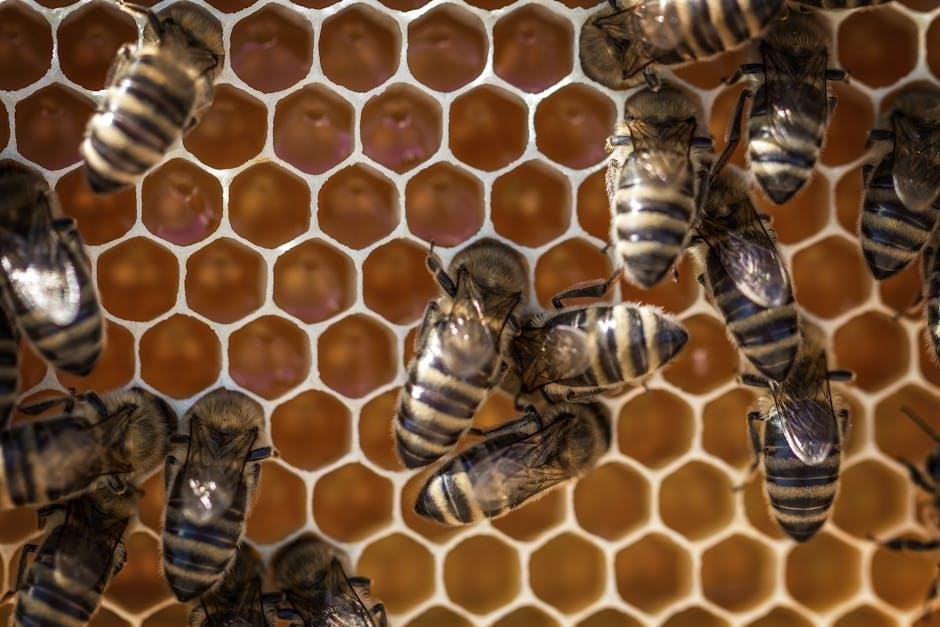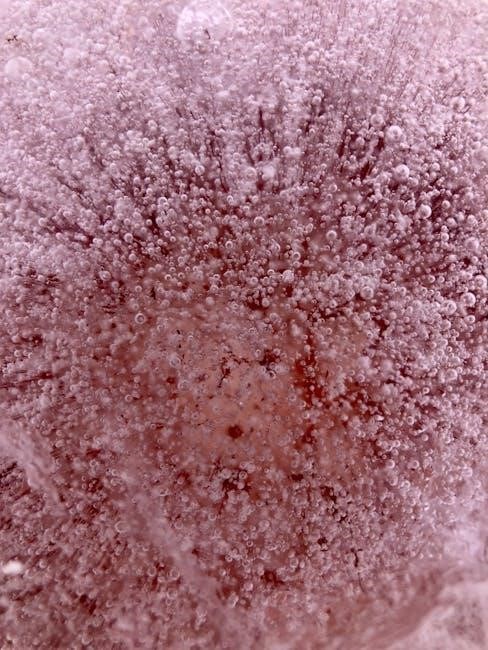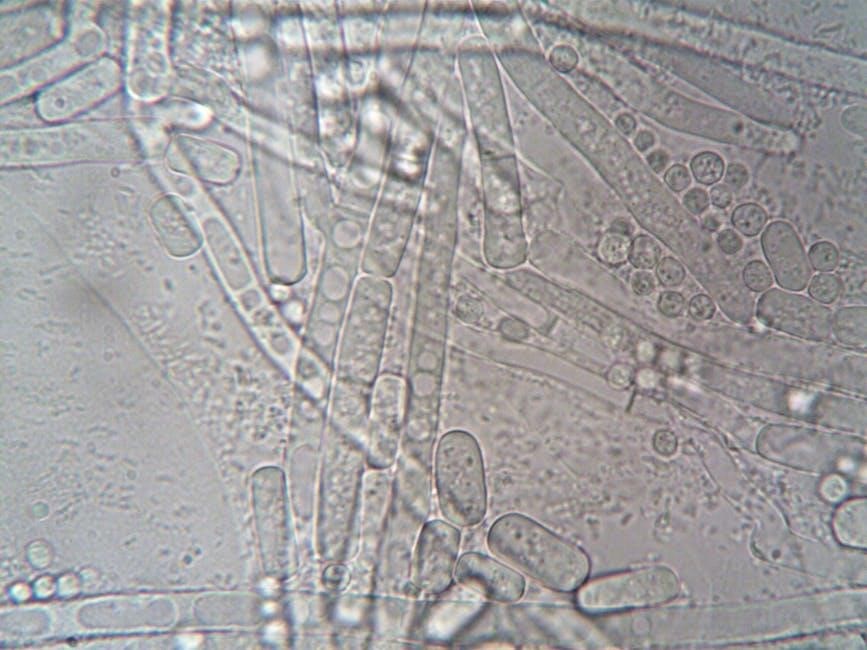Cell structure forms the foundation of biology, exploring the organization and function of cells, the basic units of life. Understanding cell components like membranes, organelles, and cytoplasm is essential for grasping biological processes. This section introduces key concepts, including the differences between eukaryotic and prokaryotic cells, and the significance of studying cellular organization. By examining cell structure, we uncover the intricate mechanisms that sustain life and enable functionality across organisms.
1.1 Overview of Cell Biology
Cell biology is the scientific study of cells, the fundamental units of life, focusing on their structure, function, and behavior. It explores how cells grow, reproduce, and interact with their environment. Cells are the building blocks of all living organisms, with plant and animal cells exhibiting specialized structures like chloroplasts and centrioles. Eukaryotic cells, unlike prokaryotic ones, contain a nucleus and organelles, enabling complex cellular processes. Understanding cell biology provides insights into life’s basic mechanisms, disease origins, and biological diversity, making it a cornerstone of modern biology and medicine.

1.2 Importance of Studying Cell Structure
Studying cell structure is crucial for understanding life’s fundamental processes, including growth, reproduction, and metabolism. It provides insights into how cells maintain homeostasis, respond to stimuli, and adapt to environmental changes. Knowledge of cell components like membranes, organelles, and cytoplasm is essential for advances in medicine, agriculture, and biotechnology. By exploring cell structure, scientists can develop new treatments for diseases, improve crop yields, and engineer novel biotechnological solutions. Additionally, it sheds light on evolutionary adaptations and the intricate mechanisms that sustain life, making it a cornerstone of biological and medical research.

Key Components of Cell Structure
Cell structure comprises key components essential for survival. The plasma membrane, cytoplasm, nucleus, and organelles work together to maintain functionality and homeostasis, enabling life processes.
2.1 Plasma Membrane
The plasma membrane is a thin, semi-permeable bilayer of lipid and protein molecules that encloses the cell and regulates the movement of substances in and out. It maintains cellular homeostasis by controlling the passage of ions, nutrients, and waste products. This membrane is crucial for cell signaling, allowing communication with external environments. Its fluidity enables dynamic interactions, while embedded proteins facilitate transport and recognition. The plasma membrane also protects the cell from harmful substances and pathogens, ensuring internal stability. This structure is vital for cellular function, balancing protection and interaction with the outside world.
2.2 Cytoplasm and Its Functions
Cytoplasm is the jelly-like substance within a cell, comprising water, salts, sugars, and various organelles. It serves as the medium for chemical reactions and metabolic processes. Cytoplasm aids in cell signaling, supports the transport of materials, and maintains cell shape. It houses ribosomes, essential for protein synthesis, and allows the movement of organelles; The cytosol, the liquid part of cytoplasm, contains enzymes that drive biochemical reactions. Cytoplasm also plays a role in cell division and energy production. Its viscosity changes with cellular activity, influencing processes like reproduction and metabolism. This dynamic environment is crucial for sustaining life and enabling cellular function.
2.3 Nucleus and Its Role
The nucleus is the control center of eukaryotic cells, housing most of the cell’s genetic material, DNA. It regulates gene expression, cell growth, and reproduction, ensuring proper cellular function. The nuclear envelope, a double membrane, protects the DNA and regulates molecular traffic through nuclear pores. Inside the nucleus, the nucleolus synthesizes ribosomal RNA and assembles ribosomes. The nucleus coordinates cell activities, responding to signals and initiating processes like metabolism and reproduction. Its role in storing and managing genetic information makes it vital for cell survival and function, acting as the central hub for cellular operations and genetic regulation.

Cell Organelles
Cell organelles are specialized structures performing unique functions essential for cell survival. Key organelles include mitochondria, endoplasmic reticulum, Golgi apparatus, lysosomes, and ribosomes, each contributing to energy production, protein synthesis, and cellular maintenance.
3.1 Mitochondria: The Powerhouse of the Cell
Mitochondria are double-membraned organelles renowned as the cell’s energy powerhouses. Their primary function is ATP production through the citric acid cycle and oxidative phosphorylation. The inner membrane’s cristae increase surface area for efficient energy synthesis. Mitochondria also regulate cellular signaling, apoptosis, and maintain calcium homeostasis. Their dynamic nature allows them to fuse, divide, and adapt to cellular demands. This organelle’s structure and function are vital for sustaining life in eukaryotic cells, emphasizing their critical role in cellular metabolism and survival.
3.2 Endoplasmic Reticulum (ER) and Its Types
The endoplasmic reticulum (ER) is a membranous organelle central to protein synthesis, lipid production, and calcium storage. It exists in two forms: rough ER and smooth ER. Rough ER, covered with ribosomes, synthesizes proteins for secretion or cellular use. Smooth ER lacks ribosomes and is involved in lipid synthesis, detoxification, and storing calcium ions. Both types form interconnected tubules and cisternae, ensuring efficient transport of molecules. The ER’s diverse functions make it indispensable for cellular operations, bridging protein synthesis with transport and storage, and maintaining cellular homeostasis through its specialized roles.
3.3 Golgi Apparatus and Its Functions
The Golgi apparatus is a complex organelle consisting of stacked, flattened sacs called cisternae. It plays a central role in protein modification, sorting, and packaging. Proteins synthesized by the rough ER are transported to the Golgi, where they are further modified, such as adding carbohydrates in a process called glycosylation. The Golgi then directs these molecules to their final destinations, whether within the cell or for secretion outside. Additionally, it synthesizes lipids and plays a role in cell wall formation in plants. Vesicles facilitate the transport of materials between the ER, Golgi, and other cellular structures, ensuring efficient distribution and functionality.

3.4 Lysosomes and Vacuoles
Lysosomes are membrane-bound organelles containing digestive enzymes that break down and recycle cellular waste, foreign substances, and damaged organelles. They play a key role in maintaining cellular cleanliness and recycling essential molecules. Vacuoles are larger, membrane-enclosed compartments that store water, salts, and other substances, contributing to cell turgor pressure. In plant cells, vacuoles are particularly prominent, aiding in cell growth and storage. Both lysosomes and vacuoles are crucial for cellular maintenance and resource management, ensuring proper cell function and integrity across various organisms.

Cytoskeleton and Cell Wall
The cytoskeleton provides structural support, shape, and aids in cell movement and transport of materials. The cell wall offers protection, maintains cell shape, and is found in plants, fungi, and bacteria, playing a crucial role in cellular stability and function across various organisms.
4.1 Structure and Function of the Cytoskeleton
The cytoskeleton is a dynamic network of filaments, including microtubules, microfilaments, and intermediate filaments. It provides structural support, maintaining cell shape and mechanical stability. Microtubules, formed from tubulin subunits, are essential for cellular transport and the movement of organelles. Microfilaments, composed of actin, play a role in cell motility and muscle contraction. Intermediate filaments add strength and resilience to cells. The cytoskeleton also aids in cell division by forming the spindle apparatus and is involved in intracellular signaling. Its versatility and adaptability make it a critical component for various cellular processes, ensuring proper function and survival of the cell.

4.2 Cell Wall: Composition and Role in Different Organisms
The cell wall is a rigid structure outside the plasma membrane, providing support, protection, and maintaining cell shape. In plants, the cell wall is primarily composed of cellulose and pectin, offering rigidity and flexibility. Fungi have cell walls made of chitin, while bacteria possess peptidoglycan, which maintains osmotic balance. Algae have varied cell wall compositions, often including silica or calcium carbonate. The cell wall is absent in animal cells but is crucial for organisms like plants, fungi, and bacteria, aiding in defense against pathogens and environmental stresses. Its composition and role vary significantly across different organisms, reflecting their unique biological needs and evolutionary adaptations.

Specialized Structures in Plant and Animal Cells
Plant cells feature chloroplasts for photosynthesis and large vacuoles for storage, while animal cells lack these but contain centrioles for cell division and lysosomes for digestion.
5.1 Chloroplasts in Plant Cells
Chloroplasts are membrane-bound organelles found in plant cells, essential for photosynthesis. They contain chlorophyll, which absorbs light energy, and are divided into thylakoids (light-dependent reactions) and stroma (Calvin cycle). These organelles produce oxygen and glucose, sustaining life and energy production in plants. Unique to plants and some algae, chloroplasts are crucial for converting light into chemical energy, enabling plants to synthesize their own food. Their structure and function highlight their vital role in supporting both plant growth and ecosystems. Without chloroplasts, plants would be unable to undergo photosynthesis, making them indispensable for life on Earth.
5.2 Centrioles in Animal Cells
Centrioles are small, cylindrical organelles found in animal cells, typically located near the Golgi apparatus. They consist of microtubules arranged in a 9+3 configuration. Centrioles play a key role in forming cilia, flagella, and spindle fibers during cell division. They help organize microtubules for mitosis, ensuring proper chromosome separation. While not essential in plants, centrioles are vital for animal cell division and motility. Their duplication occurs during the cell cycle, ensuring each daughter cell receives a pair. This specialized structure is fundamental to animal cell function and movement, highlighting their critical role in cellular processes.

Cell Organization and Theory
Cell organization refers to the structural and functional hierarchy within cells, from molecules to organelles. The cell theory, a foundational concept, states that all life consists of cells, new cells arise from existing ones, and cells are the basic units of function. This theory underscores the unity and diversity of life, emphasizing the cell as the fundamental building block across organisms. Understanding cell organization and theory provides insights into the complexity and evolution of cellular life, forming the cornerstone of biological studies.
6.1 Eukaryotic vs. Prokaryotic Cells
- Eukaryotic cells have a nucleus and membrane-bound organelles, enabling complex cellular processes.
- Prokaryotic cells lack a nucleus and organelles, with genetic material in a single circular chromosome.
- Eukaryotic cells are larger and more complex, supporting advanced metabolism and specialized functions.
- Prokaryotic cells are smaller, simpler, and thrive in diverse environments due to their adaptability.
- Eukaryotic cells include plants, animals, fungi, and protists, while prokaryotic cells include bacteria and archaea.
These distinctions highlight the evolutionary divergence in cellular organization, with eukaryotes evolving from prokaryotic ancestors.
6.2 The Cell Theory and Its Significance
The Cell Theory, formulated by Schleiden, Schwann, and Virchow, states that all life is composed of cells, cells are the basic units of life, and new cells arise from existing ones. This theory revolutionized biology by providing a unified understanding of life’s structural basis. It emphasized cells as the fundamental functional and structural units, offering a framework for understanding growth, reproduction, and disease mechanisms. The Cell Theory’s significance lies in its universal application across organisms, establishing a foundation for modern biological studies and medical advancements.
Understanding cell structure is fundamental to biology, revealing the intricate mechanisms of life. This knowledge aids in comprehending cellular functions, disease mechanisms, and biological processes, driving scientific advancements.
7.1 Summary of Key Concepts
Cell structure is fundamental to understanding biology, with key components including the nucleus, cytoplasm, and organelles like mitochondria, ER, and lysosomes. Eukaryotic cells feature a nucleus and membrane-bound organelles, while prokaryotic cells lack these. Plant cells include chloroplasts and a cell wall, whereas animal cells have centrioles. Organelles perform specialized functions, such as energy production in mitochondria and protein synthesis in the ER. The cytoskeleton provides structural support, and the plasma membrane regulates transport. Understanding these elements is crucial for grasping cellular function, disease mechanisms, and biological processes, forming the basis of advanced studies in cell biology and related fields.
7.2 The Evolution of Cell Structure Studies
The study of cell structure has evolved significantly over time, from early microscopic observations to advanced imaging techniques. Historically, scientists like Antonie van Leeuwenhoek pioneered cell visualization, while later discoveries of organelles and membrane-bound structures expanded understanding. The development of electron microscopy revealed intricate cellular details, enabling precise studies of organelles like mitochondria and the ER. Modern advancements in molecular biology and imaging technologies continue to refine our knowledge of cellular mechanisms. This evolution underscores the dynamic nature of cell biology, as new tools and methods uncover deeper insights into cellular organization and function.
